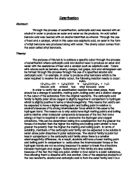Esterfication. he purpose of this lab is to achieve a specific odour through the process of esterification where carboxylic acid and alcohol react to produce an ester and water with the assistance of heat and a catalyst such as sulphuric acid.
Esterfication
Abstract:
Through the process of esterification, carboxylic acid was reacted with an alcohol in order to produce an ester and water as the products. An acid called benzoic acid was reacted with an alcohol identified as ethanol. Through the use of heat and a catalyst, which in this case was sulphuric acid, an ester in the form of ethyl benzoate was produced along with water. The cherry odour comes from the ester called ethyl benzoate.
Theory:
The purpose of this lab is to achieve a specific odour through the process of esterification where carboxylic acid and alcohol react to produce an ester and water with the assistance of heat and a catalyst such as sulphuric acid. Esters with odours such as banana, cherry, orange, red grape, rum and wintergreen can be formed through this process through the use of a specified alcohol and carboxylic acid. For example, in order to produce ethyl benzoate which is the ester required to receive the cherry odour, the following reaction needs to occur:
H2SO4
CH3CH2—OH + C6H5COOH → C6H5COOC2H5 + H2O
benzoic acid ethanol heat ethyl benzoate water
In order to verify that an esterification reaction has taken place, there should be a change in solubility, melting point, boiling point and a distinct change in the odour of the substance from the original reactants. The carboxylic acid family is highly polar since oxygen is slightly negative in comparison to hydrogen which is slightly positive in terms of electronegativity. This means that acid's can be expected to have a higher melting point and boiling point in relation to alcohol's because of its strong intermolecular force which in this case is the hydrogen bond. The reason as to why acids have high melting points and boiling points relative other molecular compounds is because of the fact that more energy or heat is required in order to overcome the hydrogen and oxygen attractions. This can be determined taking into consideration that the greater the forces of attraction then the higher the melting and boiling point similar to how greater the polarity then the higher the melting and boiling point. In terms of solubility, members of the carboxylic acid family can be expected to be soluble in water since polar dissolves in polar substances. The alcohol family is polar but less in comparison to the carboxylic acid family since there is a smaller electronegativity difference. As a result, alcohols will have a lower melting point and boiling point in comparison to acids since the intermolecular forces or the hydrogen bonds are not as strong because it is easier to break the attractions between hydrogen and oxygen. Substances of this family are also soluble because of the fact that they are polar, similar to how water is a polar substance, thus allowing them to dissolve with one another. One of the expected product's of the two reactant's, alcohol and carboxylic acid is from the ester family and it is a non-polar compound because the electron charges are evenly distributed amongst the elements. This means that it can be expected for it to have a lower boiling and melting point in comparison to alcohols and acids since there is no bonding between hydrogen and oxygen meaning that there is no hydrogen bonding present. Instead, the intermolecular force present within an ester is the London Force which is the weakest in terms of relative strength of attraction allowing attraction between the electrons of neighbouring molecules. Esters are also insoluble in water because they are non-polar while water is polar, not allowing one to dissolve in the other.








